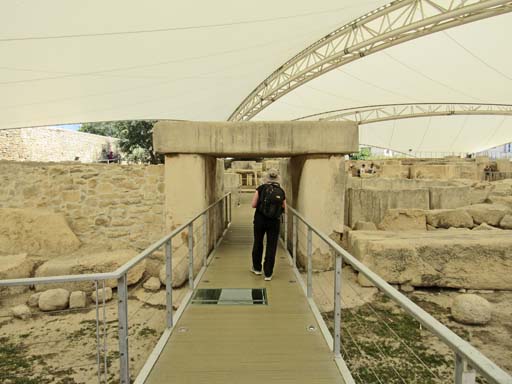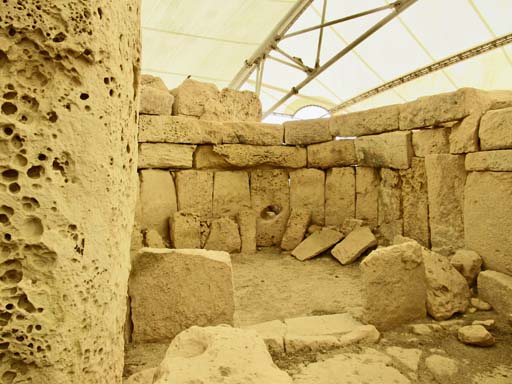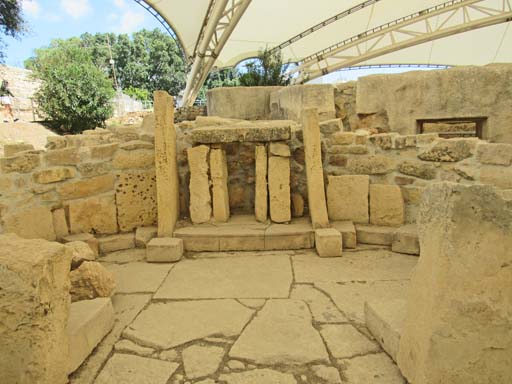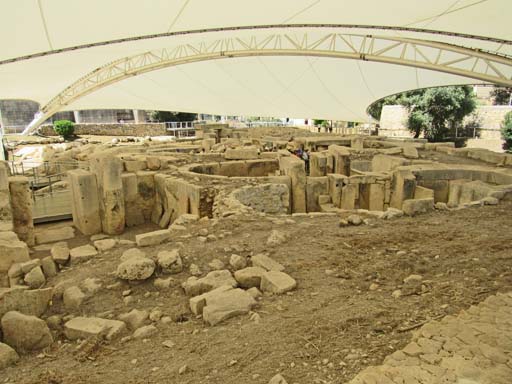So now we get to the chief reason I wanted to go to Malta in the first place: to view the gigantic stone monuments found on the island.
There is nothing like them anywhere else. They were built out of the local limestone roughly 3500-2500 BCE— before the Pyramids, before Stonehenge. They are right smack at the beginning of history. Until the recent discovery of Göbekli Tepe in Turkey, these were believed to be the oldest freestanding monuments in the world.
I have a deep fascination with the Neolithic and the sorts of things people did and believed. Their belief systems seem alien and impenetrable, but yet they were a deeply practical people— they knew how to build all those monuments, for one thing.
No good story ideas have come out of this yet, but I live in hope.
There are two kinds of monuments to be found on Malta: temples and hypogeums, which are underground burial complexes that held thousands of human bones. I managed to view the two temples closest to Valetta: Ħaġar Qim and Tarxien.
The temples are all within sight of the sea, and built to a standard design: you enter through a large trilithon gate into an open space, from which you can proceed to a number of lobe-shaped chambers, usually three but sometimes more. The temples also have an astronomical function, with the sun intended to enter the temple at the equinox or solstice. Unlike other megalithic monuments, where the builders went to considerable trouble to arrange the stones to provide a passage for sunlight, the builders here just knocked holes in the already-standing stones to let the light in, as seen in the central stone above.
The temples had roofs of wood or of skins, which have not survived.
The shafts of light are directed onto various slabs of limestone which presumably had significance to the builders, however meaningless they are to us. Possibly there was something else there, an idol or other special object, but most of the monuments weren’t excavated properly so we may never know.
Excavations began in the early 19th century, when archaeology was far from a mature discipline. Most were excavated by local enthusiasts, in some cases by neighboring farmers. They discovered massive amounts of artifacts, then took them home, and eventually lost track of them. Even the more professional digs didn’t understand about context, so if they found an artifact they may have recorded it, but they wouldn’t record where it was found in relation to anything else. One professional archaeologist headed a dig, then decided to become a missionary in Tunisia and left without publishing his discoveries.
The result is that we’re missing a lot.
The principle deity worshipped at the temples seems to have been hermaphroditic, or perhaps completely asexual. The being’s lower body is that of a highly exaggerated female, with enormous thighs, buttocks, stomach, and hips. The upper body seems to be male, with equally exaggerated features, and without breasts. Because of the superficial resemblance to “Venus figurines” found in Europe and Eurasia, archaeologists originally thought the Maltese were part of the widespread mother-goddess cult they were then inclined to believe existed, but it’s now appearing that Maltese religion was original to the island.
Many scattered animal bones indicate animal sacrifice was an element of the religion. There are no human bones found in the temples.
The standing stones, which weigh tons, were rolled to the site while riding cannonball-shaped stones that acted like ball bearings. The rolling stones are still scattered around the temples where they were abandoned when their job was done.
A short distance away was the Hypogeum of Ħal Saflieni, which I very much wished to see, but apparently tickets are limited. This is an underground burial complex that contained the remains of 7-8000 people. Originally the bodies were deposited whole into the structure, but later the hypogeum became used as an ossuary, with the bodies being dismembered, and skulls stored in one place while femurs were stored elsewhere, etc.
Examination of the remains shows that most of the Maltese came from Sicily, with a large minority originating in Africa. There are no signs of conflict between whatever groups existed— no city walls, no warrior burials, no weapons. The locals got along, and the islands were too difficult for outsiders to invade.
Some of the later burials show sign of genetic disease, so possibly there was too much inbreeding going on.
The temples and other sites were used for a thousand years, and then abandoned. They weren’t destroyed, but left to the elements. The Maltese gave up on their religion, presumably because it had stopped working for them. The current theory is that environmental degradation resulted in reduced crop yields and produced a shrinking and sickening population. There was 50% infant mortality, which argues that conditions got pretty dire.
The original population was succeeded by a Bronze Age culture that built a few dolmens and vanished. Nothing much happened until the Phoenicians conquered the place in the 8th Century BCE.
But underground, buried in rubble, the great monuments waited. For us lucky few, as it turns out.




This is fascinating! I’m intrigued by the *lithic ages myself, and have been on a bit of a pre-history kick over the last few years. There’s a really great documentary by some amateur archaeologists in the UK called Standing With Stones (available on YouTube), which takes you from Cornwall to the Orkney Islands with a swing through Ireland.
Comments on this entry are closed.